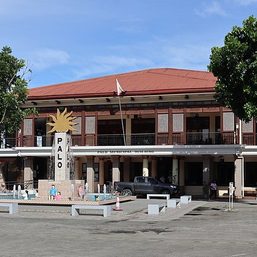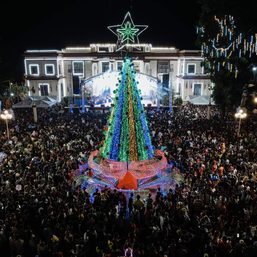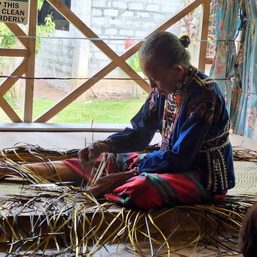SUMMARY
This is AI generated summarization, which may have errors. For context, always refer to the full article.

BAGUIO, Philippines – The soft, rhythmic tapping of wooden sticks fills the air at Igorot’s Charm Cafe, a sound that transports listeners back to a time when tattoos were not just skin deep but carried the weight of cultural heritage and personal identity.
Wilma “Ate Wamz” Gaspili, a manbabatek (traditional tattoo practitioner in Kankanaey), sits poised and focused, her hands steady as she prepares to ink yet another intricate design onto the skin of a client.
Gaspili’s journey to becoming a manbabatek is as intricate and layered as the tattoos she creates. Her path took a notable turn when Filipino-American comedian Jo Koy visited Baguio in January 2023 and chose her to ink a part of his story onto his skin.

“He came to my booth across the Baguio Botanical Garden where there was a small art fair. I was so shy, I told him I was new [to tattooing], so I was not very good yet,” Gaspili recalled.
She said the comedian told her, “I don’t care, you have the right. You have your own identity, so why not?”
The next day, there was a line of people outside of her cafe–fans of Jo Koy, all wanting to get inked by her too.
We have a mutual friend, so I sent Gaspili a message through social media, asking when she would be back in Baguio because I wanted to meet her and talk about this Cordilleran traditional hand-tap tattooing method. She had participated at the 18th China Tattoo Convention in Hebei and a Fireside Chat on Independence Day at the Embassy of the Philippines in Beijing.
She invited me to her cafe to observe as she tattooed a friend.
When I arrived at 2:30 pm, Gaspili was just getting Lora ready for her fourth–and biggest–tattoo.
As she used a thin blade of grass dipped in ink to make a stencil on Lora’s back, Gaspili told us that that morning, she did not yet have any idea about what pattern to use. So, she said a madmad (ritual prayer). Then, the design of a river snaking down Lora’s spine came to her.

“Sometimes, someone will choose a pattern that’s not necessarily difficult, but for some reason, I am unable to tattoo it on them. Then, I ask them to choose another design that may relate more closely to them, and the second choice could be the one meant for them,” Gaspili said.
Getting tapped
While Gaspili was hand-tapping the pattern on her back, Lora remained silent and I asked if it hurt. She confessed that out of all her tattoos, she felt pain only when Gaspili tattooed her signature pattern on Lora’s wrist: depicting sunrise at Mount Pulag–a place sacred to Gaspili’s culture–and signifying hope.
Gaspili, who is of mixed Kankanaey and Kalanguya heritage by way of Benguet and Ifugao, is a reluctant manbabatek. She became a tattoo advocate in 2018 when she went to Buscalan, Kalinga, and was tattooed by a granddaughter of legendary mambabatok Apo Whang-Od.
It unlocked something within her, a longing to find out more about her culture and traditions.
“I grew up thinking that having tattoos was dirty or unfavorable because of the stigma that our present society associates with tattoos,” she said.
Recalling that the centuries-old mummies of Benguet bore tattoos, she traveled across the Cordillera region: Benguet, Mountain Province, Kalinga, Ifugao, and Abra and interviewed elders about tattoos.
“I found out that aside from being a mark of warriors’ bravery after returning from battles, tattoos were also considered marks of beauty. Women in the Mountain Province were not welcomed in social gatherings unless they were tattooed. So they used to work in the fields or cook delicious food in exchange for getting tattoos,” said Gaspili.
She also observed that some women had tiny tattoos. When she asked why, they answered that they had tried to tattoo themselves, but they could not handle the pain, so they gave up.
“So those women who got full-sleeve tattoos are the brave ones,” Gaspili said. “What I’ve experienced in life is worse than what I went through when I got these tattoos.”
After she told us about the difficulties she had to overcome in her home life, I mused that her tattoos–covering her arms, chest, and legs–accumulated over the years, are her marks of victory.
Great awakening
Gaspili never intended to be a manbabatek. After working in Hong Kong for five years, where she also completed a culinary arts course, she opened her cafe. But after hosting traditional tattooing events there, she found that “cooking is my passion, but tattooing is my calling.”
She said, “Our ancestors all over the Philippines had tattoos, but colonization made it taboo. All over the world, many indigenous people have tattoos as a tradition. I have found this affinity with fellow IPs (indigenous people), for example, from New Zealand, Borneo, and Mexico. Tattooing is part of our cultures; we just use different patterns and designs and ascribe different meanings to them.”
According to Kenneth Kelcho of the Benguet Museum, tattooing in Benguet was stopped during the American occupation due to public health concerns.
“Many people were dying from infections because there was no pain reliever, no prophylaxis nor other medicines,” he said.
However, it did not eradicate the practice but merely moved it to the margins.

Tattoo tools
Wooden sticks are central to the tattooing process. A lemon tree thorn is attached to one stick, while a bigger stick is used for tapping.
Gaspili mixes water from Mount Pulag with soot from pine wood sourced from places like Kabayan and Buguias in Benguet, and Nueva Vizcaya, to make the ink. She mixes a new batch for each client.
People have suggested that she mix a big batch of ink in advance to make the process faster, but she strives for authenticity, so she devotes time to every step.
“People like to observe the process and hear the stories behind it,” she said.
The rhythmic tapping of the sticks is hypnotic, and relaxing. After I made this observation, Gaspili stopped to ask, “Oh, so, are you going to get a tattoo now?”
I winced because I have a low pain threshold.
Going places
Nowadays, Gaspili keeps a steady schedule of engagements from Borneo and Kuala Lumpur in Malaysia to Hawaii.
“I join tattoo conventions but I don’t compete. I promote our culture because that’s a good venue, with people who appreciate tattoos, to increase awareness about indigenous tattoos in the Philippines. I also make connections and establish networks there. Then, we are invited to each other’s countries for cultural exchange,” she said.
Gaspili said she is not in it for the money, and sees it as her responsibility as culture bearer to preserve this practice and increase appreciation for it.
In Borneo, for instance, she exchanged cultural traditions, including tattoos, with the indigenous Iban, without any money involved.
Though she has been received warmly in different countries, she has also experienced bashing, with someone accusing her online of giving away her culture.
Gaspili responded, “I cannot give away my culture, I am just sharing it.”
Some Filipinos have asked her whether they can also get these traditional tattoos even if they are not Cordilleran. Her answer: “Tattoos are part of your identity, too. As long as you respect and embrace our culture. You are Filipino too, after all.”

There are lines, however, that Gaspili will not cross.
“I will not tattoo someone with Apo Whang-Od’s signature three dots, out of respect,” she said. Neither will she tattoo the exact same patterns as Kalinga warriors.
Gaspili denied she has ever claimed that she is related to the legendary mambabatok. Instead, she said, she traces her lineage to Apo Anno, one of the tattooed Benguet mummies.
“I honor my ancestors and our heritage by being a tattoo practitioner. I preserve our traditional practices and share our culture. Through this, we can better understand each other. We have more things in common than differences,” she said. – Rappler.com
Add a comment
How does this make you feel?






















There are no comments yet. Add your comment to start the conversation.